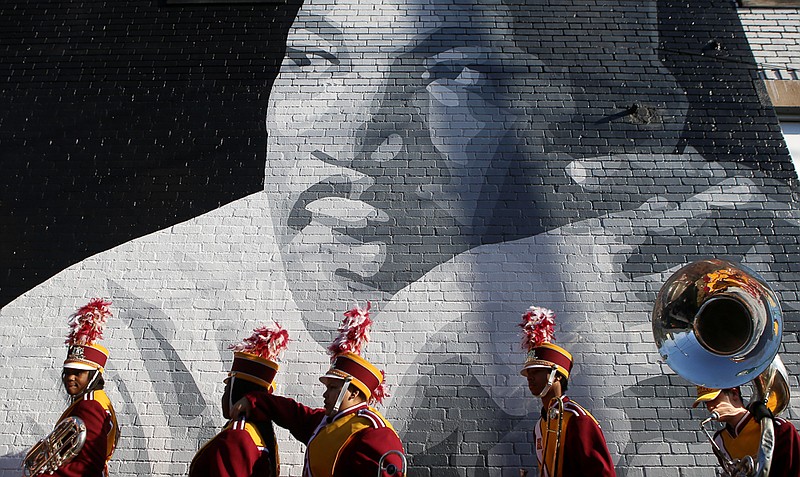"I still have a dream. It is a dream deeply rooted in the American dream. I have a dream that one day this nation will rise up and live out the true meaning of its creed: 'We hold these truths to be self-evident: that all men are created equal.' I have a dream that my four little children will one day live in a nation where they will not be judged by the color of their skin but by the content of their character."
Those words still inspire us. Still make chills run along our spines and still make us stand taller with pride.
They were the words of Dr. Martin Luther King Jr. at the culmination of the historic March on Washington in August 1963 - a truly peaceful protest at our Capitol - an interracial assembly of more than 200,000 who gathered in the shadow of the Lincoln Memorial to demand equal justice for all citizens under the law.
King's speech, now world famous and dubbed the "I Have a Dream" speech, was intended to be brief, and nowhere on the three-page, type-written copy that King began reading from was the word "dream."
But several minutes in, the Baptist minister - and son and grandson of Baptist ministers - stopped reading and looked up to those in front of him and to the skies above. He began just talking, preaching, reaching the rainbow of people who had shown up in support of equality in jobs and freedom.
He picked up a line that he'd used a week earlier in Chicago; two months earlier at a mass rally in Detroit; and several other times in the previous year, according to historians. But this time, the audience was larger and in a tense Capitol where troops were massed just outside the city in case President Kennedy had to sign the already-prepared martial-law orders.
Sound vaguely familiar?
But unlike the racist, mostly white mob that assaulted the Capitol earlier this month, stoked by a soon-to-be former president who at every opportunity has sought to radicalize the white supremacists among us, the peaceful marchers of 1963 were uplifted by the emotional strength and prophetic quality of King's speech, in which he emphasized his faith that all men, someday, would be brothers.
Still, it wasn't until King's assassination nearly five years later that the speech would become immortal - one of the things we use to define what America means.
As King spoke that day, more than two-thirds of the nation's Black people lacked the right to vote, to attend integrated schools or to use the same public facilities as whites.
But his speeches and rallies that year - along with those of many other activists - made civil rights the nation's top domestic political issue.
Now, nearly 60 years later, we see some clear gains, but not enough.
In 1965, two years after King's "I Have a Dream" speech, the Voting Rights Act directed the attorney general to enforce the right to vote for Blacks. The new law prohibited states from using literacy tests and other methods of excluding Blacks from voting. Before this, only an estimated 23% of voting-age Blacks were registered nationally, but by 1969 the number had jumped to 61%.
From 2000 to 2018, the nation's eligible voter population grew from 193.4 million to 233.7 million - an increase of 40.3 million. Nonwhite voters account for more than three-quarters of that increase, according to the Pew Research Center, and it might be higher were it not for the Supreme Court's decision in 2013 to gut the Voting Rights Act, prompting several majority Republican states like Tennessee and Georgia to make it harder for minorities to vote.
There is other, clearer stagnation.
Almost all of the Black economic gains of the 1980s, 1990s and early 2000s were lost after the recession that began in late 2007. Black household income fell two and a half times farther than white household income during that recession, and Black home ownership rates fell at roughly double the rates of whites. By 2010, the median household income for Blacks was 30 percent less than the median income of white households 30 years before.
Today, for the first time since, Black median household income finally has edged back to its 2007, $41,511 peak. Still, in 2018 Black households earned 59 cents on every dollar earned in white households (less locally), and the poverty rate among Blacks is still twice that of whites.
Then came COVID-19 to turn a magnifying glass on structural racism and highlight both work and public health issues for people of color.
Black and Latino people have coronavirus infection rates nearly three and four times that of whites, and Blacks are twice as likely to die from the virus. That's because Black and Latino Americans are more likely to live in crowded housing conditions and to work in essential jobs which cannot be performed from home. They also are more likely to suffer from pre-existing conditions that increase their risk, and they are more likely to lack insurance.
Amid all this, we must not forget the horrific deaths of George Floyd, Rayshard Brooks, Breonna Taylor, Ahmaud Arbery and other Black Americans at the hands of police whose policies are in desperate need of reform.
Great social movements like what Dr. King foresaw and worked toward often are marked by clear turning points, when major shifts in attitude and understanding spur us to act with new urgency.
We believe we are in such a moment now.
We cannot let go of Dr. King's dream. Our dream. Let freedom ring.
